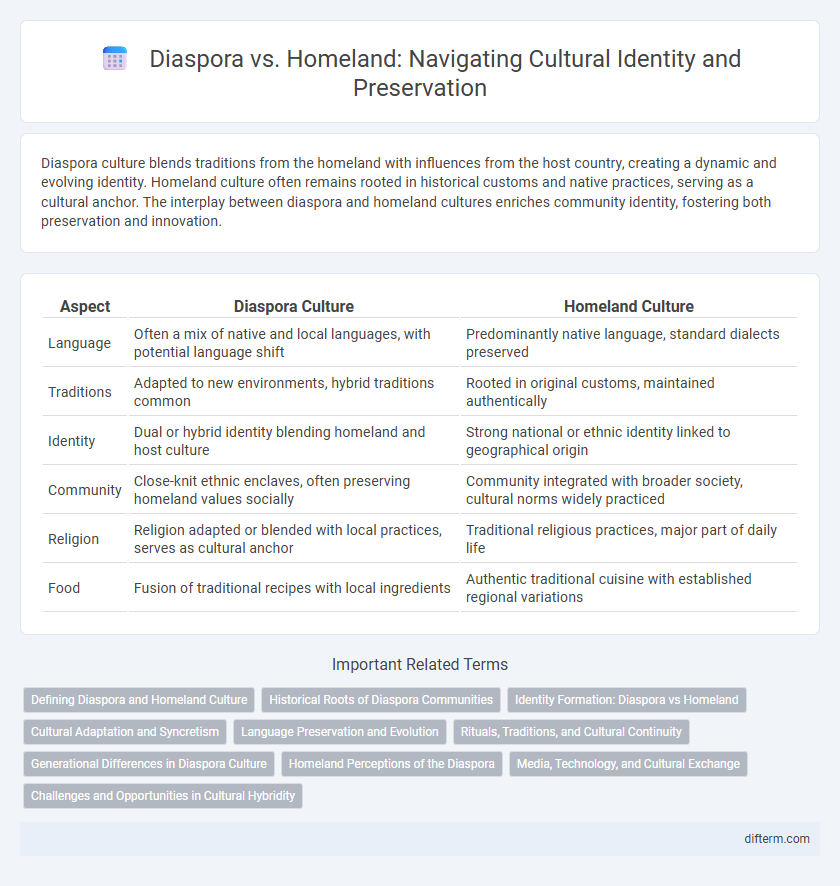Diaspora culture blends traditions from the homeland with influences from the host country, creating a dynamic and evolving identity. Homeland culture often remains rooted in historical customs and native practices, serving as a cultural anchor. The interplay between diaspora and homeland cultures enriches community identity, fostering both preservation and innovation.
Table of Comparison
| Aspect | Diaspora Culture | Homeland Culture |
|---|---|---|
| Language | Often a mix of native and local languages, with potential language shift | Predominantly native language, standard dialects preserved |
| Traditions | Adapted to new environments, hybrid traditions common | Rooted in original customs, maintained authentically |
| Identity | Dual or hybrid identity blending homeland and host culture | Strong national or ethnic identity linked to geographical origin |
| Community | Close-knit ethnic enclaves, often preserving homeland values socially | Community integrated with broader society, cultural norms widely practiced |
| Religion | Religion adapted or blended with local practices, serves as cultural anchor | Traditional religious practices, major part of daily life |
| Food | Fusion of traditional recipes with local ingredients | Authentic traditional cuisine with established regional variations |
Defining Diaspora and Homeland Culture
Diaspora culture refers to the customs, beliefs, and practices maintained by communities living outside their ancestral homeland, often blending elements from both their origin and host societies. Homeland culture denotes the traditional ways of life, language, rituals, and values rooted in the geographic and historical context of the native territory. Understanding the dynamic interplay between diaspora and homeland culture reveals how identity, heritage, and social norms evolve across generations and borders.
Historical Roots of Diaspora Communities
Diaspora communities preserve historical roots by maintaining linguistic traditions, religious practices, and folklore that originated in their homeland, fostering a strong cultural identity despite geographic displacement. These communities often adapt their customs to new environments while retaining core elements that reflect their ancestral history. The continuity of such cultural expressions helps bridge generations and sustains a shared heritage across continents.
Identity Formation: Diaspora vs Homeland
Diaspora communities navigate complex identity formation by blending homeland traditions with new cultural influences, creating hybrid identities that reflect both attachment and adaptation. Homeland culture provides a foundational sense of history and belonging, while diaspora experiences often introduce fluidity and negotiation in identity expression. This dynamic interplay shapes individual and collective identities, influencing cultural preservation and innovation within diaspora populations.
Cultural Adaptation and Syncretism
Diaspora communities engage in cultural adaptation by blending homeland traditions with influences from their host societies, resulting in dynamic syncretic practices. This syncretism fosters the preservation of core cultural identities while enabling innovation and cross-cultural exchange. The ongoing interaction between diaspora and homeland cultures creates evolving cultural expressions that reflect resilience and hybridity.
Language Preservation and Evolution
Diaspora communities actively preserve homeland languages through cultural practices, educational programs, and media, ensuring linguistic heritage remains vibrant despite geographical separation. Language evolution occurs as diaspora groups integrate local expressions, creating hybrid dialects that reflect both ancestral roots and new cultural influences. This dynamic interplay fosters resilient identities while adapting to changing social environments, sustaining cultural continuity across generations.
Rituals, Traditions, and Cultural Continuity
Diaspora communities maintain cultural continuity by adapting homeland rituals and traditions to new environments, fostering a sense of identity and belonging. These rituals, often modified yet deeply symbolic, serve as vital links to ancestral heritage and reinforce collective memory across generations. The dynamic interplay between preserving authentic practices and embracing contextual changes ensures the survival and evolution of cultural expressions within diaspora populations.
Generational Differences in Diaspora Culture
Generational differences in diaspora culture manifest in varying degrees of cultural retention and adaptation, with older generations often preserving homeland traditions more rigorously, while younger generations blend these practices with the influences of their host country. The tension between maintaining heritage languages, religious customs, and traditional values often contrasts with the younger diaspora's integration into the dominant societal norms and digital culture. Intergenerational dialogue and community initiatives play a crucial role in negotiating identity, ensuring cultural continuity without stifling the evolution shaped by migration experiences.
Homeland Perceptions of the Diaspora
Homeland perceptions of the diaspora often reflect a complex mix of pride and skepticism, as communities value diaspora contributions to cultural preservation and economic support while questioning authenticity and assimilation levels. These perceptions influence policies on citizenship, remittances, and cultural exchange programs aimed at strengthening diasporic ties. Research shows that positive homeland views can enhance diplomatic relations and foster a transnational identity among diaspora populations.
Media, Technology, and Cultural Exchange
Diaspora communities leverage digital media platforms and emerging technologies to preserve and share homeland culture, fostering a dynamic cultural exchange that transcends geographic boundaries. Social media, streaming services, and virtual reality experiences enable continuous engagement with traditional art, language, and customs, while also allowing for hybrid cultural expressions influenced by host countries. This technological mediation enhances cross-cultural dialogue, promoting understanding and innovation between diaspora populations and their countries of origin.
Challenges and Opportunities in Cultural Hybridity
Diaspora communities often navigate the complex challenges of preserving homeland culture while adapting to host societies, creating a dynamic space for cultural hybridity. This fusion leads to innovative expressions that enrich both diaspora and homeland identities, fostering cross-cultural understanding and resilience. Embracing hybridity offers opportunities for revitalizing traditions and promoting inclusive narratives amid global migration trends.
diaspora vs homeland culture Infographic

 difterm.com
difterm.com